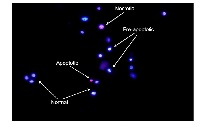In vitro inhibition of the growth of glioblastoma by Teucrium polium crude extract and fractions
Keywords:
Teucrium polium, Glioblastoma multiform, Cytotoxicity, Differential stainingAbstract
The cytotoxic effects of Teucrium polium (Lamaceae) have been shown in some studies. However, the antitumor activity of the fractions of this herb has not been studied, neither has the pattern of cell death been evaluated yet. The inhibitory effect of Teucrium polium (T. polium) on U87 cells was evaluated by treatment of U87 cells with various concentrations of crude extract (CE), a petroleum ether (PE) fraction and a diethyl ether (DE) fraction of T. polium for 24 and 48 h. Trypan blue and differential staining were also used to assess the cell viability and the pattern of cell death. CE, PE and DE inhibited cell growth in a dose-dependent manner, and this inhibition was accomplished by necrotic cell death, as assessed by differential staining. The highest inhibitory effect (IC50=64.47) was demonstrated by the PE fraction of T. polium followed by the DE fraction and the CE. Cell death was also higher when U87 cells were treated with PE (P<0.001 compared with other treated groups). Necrotic cells were predominant in all treated groups including CE, PE and DE. The results suggest that the PE fraction of T. polium is the most potent against U87 cells. The antitumor effect of the PE fraction of T. polium is probably executed through the necrotic cell death mechanism.
References
. Jemal A, Murray T, Ward E, Samuels
A, Tiwari RC, Ghafoor A, Feuer EJ,
and Thun MJ, Cancer statistics, 2005.
CA Cancer J Clin. 2005; 55(1): 10-30.
. Cho WC, Contribution of
oncoproteomics to cancer biomarker
discovery. Mol Cancer. 2007; 6: 25.
. Ghose AK, Herbertz T, Salvino JM,
and Mallamo JP, Knowledge-based
chemoinformatic approaches to drug
discovery. Drug Discov Today. 2006;
(23-24): 1107-14.
. Rasekh HR, Khoshnood-Mansourkhani
MJ, and Kamalinejad M, Hypolipidemic
effects of Teucrium polium in rats.
Fitoterapia. 2001; 72(8): 937-9.
. Suleiman MS, Abdul-Ghani AS, AlKhalil S, and Amin R, Effect of
Teucrium polium boiled leaf extract on
intestinal motility and blood pressure. J
Ethnopharmacol. 1988; 22(1): 111-6.
. Tariq M, Ageel AM, al-Yahya MA,
Mossa JS, and al-Said MS, Antiinflammatory activity of Teucrium
polium. Int J Tissue React. 1989;
(4): 185-8.
. Mansouri S, Inhibition of
staphylococcus aureus mediated by
extracts of Iranian plants.
Pharmaceutical Biology. 1999; 37:
-377.
. Atapour M, Zahedi MJ, Mehrabani M,
Safavi M, Keyvanfard V, Foroughi A,
Siavoshi F, and Foroumadi A, In vitro
susceptibility of the Gram-negative
bacterium Helicobacter pylori to
extracts of Iranian medicinal plants.
Pharmaceutical Biology. 2009; 47(1):
-80.
. Esmaeili MA and Yazdanparast R,
Hypoglycaemic effect of Teucrium
polium: studies with rat pancreatic
islets. J Ethnopharmacol. 2004; 95(1):
-30.
. Nematollahi-mahani SN, Rezazadehkermani M, Mehrabani M, and
Nakhaee N, Cytotoxic effects of
Tecurium polium on some established
cell lines. Pharmaceutical biology.
; 45(4): 295-298.
. Eskandary H, Rajabalian S, Yazdi T,
Eskandari M, Fatehi K, and Ashraf
ganjooei N, evaluation of cytotoxic
efects of Teucrium polium on a new
glioblastoma multiforme cell line
(REYF-1) Using MTT and soft agar
clonogenic assays. Int j pharmacol.
; 3(5): 435-437.
. Menichini F, Conforti F, Rigano D,
Formisano D, Piozzi F, and Senatore
F, Phytochemical composition, antiinflammatory and antitumour activities
of four Teucrium essential oils from
Greece. Food Chemistry. 2009;
(2): 679-686
. Rajabalian S, Methanolic extract of
Teucrium polium L. potentiates the
cytotoxic and apoptotic effects of
anticancer drugs of vincristine,
vinblastine and doxorubicin against a
panel of cancerous cell lines. Exp
Oncol. 2008; 30(2): 133-8.
. Mahaley MS, Jr., Mettlin C, Natarajan
N, Laws ER, Jr., and Peace BB,
National survey of patterns of care for
brain-tumor patients. J Neurosurg.
; 71(6): 826-36.
. Nematollahi-Mahani SN, RezazadehKermani M, Latifpour M, and
Salehinejad P, Biological and
Biochemical Characteristics of Human
Umbilical Cord Mesenchymal Cells. j
reprod infertil. 2008; 9(1): 7-15.
. Weiss ML, Anderson C, Medicetty S,
Seshareddy KB, Weiss RJ,
VanderWerff I, Troyer D, and McIntosh
KR, Immune properties of human
umbilical cord Wharton's jelly-derived
cells. Stem Cells. 2008; 26(11): 2865-
. Aghaee-afshar M, Rezazadehkermani
M, Asadi A, Malekpour-afshar R,
Shahesmaeili A, and Nematollahimahani SN, Potential of Human
Umbilical Cord Matrix and Rabbit Bone
MarrowăDerived Mesenchymal Stem
Cells in Repair of Surgically Incised
Rabbit External Anal Sphincter. Dis
colon rectum. 2009; 52(10): 1753-
. Shimizu S, Eguchi Y, Kamiike W, Itoh
Y, Hasegawa J, Yamabe K, Otsuki Y,
Matsuda H, and Tsujimoto Y, Induction
of apoptosis as well as necrosis by
hypoxia and predominant prevention of
apoptosis by Bcl-2 and Bcl-XL. Cancer
Res. 1996; 56(9): 2161-6.
. Charlwood BV and Banthorpe DV,
Methods in plants biochemistry.
Terpenoids, ed. P.M. Dey and J.B.
Harborne. Vol. 7 1991: Achademic
press. 278-280.
. Nagao Y, Ito N, Kohno T, Kuroda H,
and Fujita E, Antitumor activity of
Rabdosia and Teucrium diterpenoids
against P 388 lymphocytic leukemia in
mice. Chem Pharm Bull (Tokyo). 1982;
(2): 727-9.
. Bedir E, Tasdemir D, Calis I, Zerbe O,
and Sticher O, Neo-clerodane
diterpenoids from Teucrium polium.
phytochemistry. 1999; 51: 921-925.
. Esmaeili MA, Zohari F, and Sadeghi H,
Antioxidant and protective effects of
major flavonoids from Teucrium polium
on beta-cell destruction in a model of
streptozotocin-induced diabetes.
Planta Med. 2009; 75(13): 1418-20.
. Ljubuncic P, Dakwar S, Portnaya I,
Cogan U, Azaizeh H, and Bomzon A,
Aqueous Extracts of Teucrium polium
Possess Remarkable Antioxidant
Activity In Vitro. Evid Based
Complement Alternat Med. 2006; 3(3):
-38.
. Torres K and Horwitz SB, Mechanisms
of Taxol-induced cell death are
concentration dependent. Cancer Res.
; 58(16): 3620-6.



